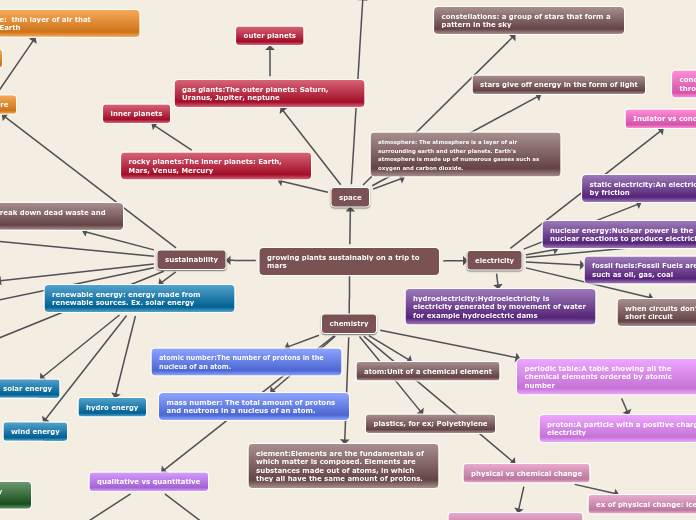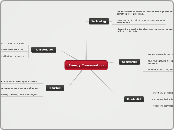growing plants sustainably on a trip to mars
sustainability
inputs and outputs of photosynthesis and cellular respiration
outputs of photosynthesis: oxygen, glucose
outputs of cellular respiration: carbon dioxide, energy, water
inputs of photosynthesis: Carbon dioxide, energy, water
inputs of cellular respiration: oxygen, glucose
biosphere
Hydrosphere: all water on/above or below Earth's surface
atmosphere: thin layer of air that surrounds Earth
lithosphere: rocky outer layer of earth
decomposers break down dead waste and turn it into soil
cellular respiration
done by plants and animals
photosynthesis:It is a process by plants and animals and organisms to create energy.
food chain:A chain of organisms that depend on each other as food. For example:
consumers
herbivore: an organism that eats only plants (ex: deer)
omnivore: an organism that eats plants and animals (ex: humans)
Carnivores: An organism that eats only meat (ex: Lion)
renewable energy: energy made from renewable sources. Ex. solar energy
hydro energy
wind energy
solar energy
electricity
current electricity: a stream of charged particles, such as electrons or ions, moving through an electrical conductor or space
Inulator vs conductor
Insulator does not let energy/electricity to pass through
conductor allows energy/electricity to pass through
when circuits don't have a load they cause a short circuit
static electricity:An electric charge caused by friction
fossil fuels:Fossil Fuels are natural process such as oil, gas, coal
nuclear energy:Nuclear power is the use of nuclear reactions to produce electricity
hydroelectricity:Hydroelectricity is electricity generated by movement of water for example hydroelectric dams
chemistry
qualitative vs quantitative
Quantitative can be measured by numbers.
qualitative can be categorized based off of characteristics.
physical vs chemical change
ex of physical change: ice melting
ex of chemical change: baking
periodic table:A table showing all the chemical elements ordered by atomic number
neutron: a particle with no charge
electron: a particle with a negative charge
proton:A particle with a positive charge of electricity
plastics, for ex; Polyethylene
atom:Unit of a chemical element
element:Elements are the fundamentals of which matter is composed. Elements are substances made out of atoms, in which they all have the same amount of protons.
mass number: The total amount of protons and neutrons in a nucleus of an atom.
atomic number:The number of protons in the nucleus of an atom.
space
solar system: all planets that circle 1 or more stars
constellations: a group of stars that form a pattern in the sky
stars give off energy in the form of light
rocky planets:The inner planets: Earth, Mars, Venus, Mercury
inner planets
gas giants:The outer planets: Saturn, Uranus, Jupiter, neptune
outer planets
atmosphere: The atmosphere is a layer of air surrounding earth and other planets. Earth's atmosphere is made up of numerous gasses such as oxygen and carbon dioxide.









